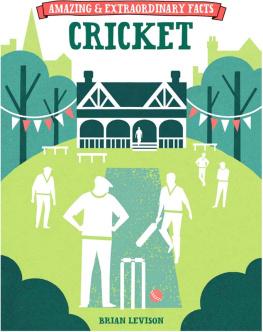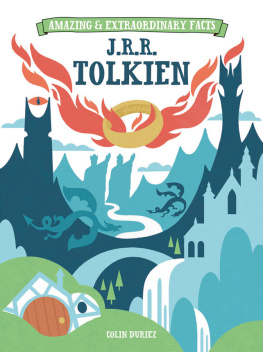Amazing & Extraordinary Facts: Cricket
Brian Levison
Introduction
Players know that there is rarely a cricket match where something doesnt happen worth talking about afterwards in the dressing room. If the incident is funny or unusual enough, it gets repeated in the pub, passed to the next team played, or it makes the local newspaper. Sometimes the many cricket trivia websites pick it up and it begins to develop a life of its own.
A good story is a good story, whether the episode took place on the village green or at Lords, and the best have been included in this book. Gathered from across the cricketing world, they cover the period from the earliest days of recorded cricket in the mid-eighteenth century, right up to the present day. Here you will find false teeth, Jack the Ripper, the cycling cricketer, coconuts and the Worcester Cathedral clock. There are appearances by dominating personalities such as W.G. Grace and Sir Donald Bradman. You will also meet players whose cricketing impact was minimal, such as Frederick Hyland. His entire first-class career lasted for about five minutes, but his prominence in cricket lore is greater than many cricketers who played much longer (see ).
You may be surprised to learn that a Hollywood actor captained England (see ) in the spotlight for a fleeting moment.
However unbelievable some of the stories may seem, theyve been as thoroughly verified as far as checking allows, usually from two independent sources. This has meant adjusting one or two received versions. The Glamorgan bowler Peter Judge wasnt out bowled first ball in two innings within five minutes, although something like it did occur (see ).
And the stories keep coming. Just too late to make it into the book, The Guardian has reported that the umpires in a Lancashire v. Warwickshire game at Liverpool had to switch off the walkie-talkies they use to communicate with scorers because they were receiving messages from a local taxi firm.
I have had an enormous amount of assistance from Andrew Ward, Jill Haas, Derek Barnard, Matthew Levison and Jordan Urban, and take this opportunity to thank them very much for their time and help. Cricket must be one of the best-served sports for ease of accessing obscure information and the ability to find the scorecard of almost every game ever played on sites such as ESPN Cricinfo and CricketArchive was hugely helpful and time saving.
Abbreviations have been used to avoid tedious repetition of names in full and are listed at the back of the book, together with a short glossary of terms that may not be familiar to everyone.
The Iron Frame
How the Laws were changed to prevent cheating
These days the dimensions of bats, balls, stumps and probably the size of cap peaks are all carefully set out in the MCC Laws of Cricket. But this was not always the case. Up until the second half of the eighteenth century, the size of bats was not formalised. A bat could be as large as a player wished and could cover the wicket (22in by 6in/56cm by 15cm), theoretically providing the batsman with an unfair advantage. However it would have been unwieldy to use and wasnt thought to be a practical proposition. In any case, it was assumed no one would use such a bat because it wasnt cricket.
In 1771 all that changed in a great cricket match as games of that era were always called between the Hambledon and Chertsey clubs. A Chertsey player named White came in with a bat as wide, if not wider, than the wicket and used it very effectively. The Hambledon players were furious not least because large stakes had been wagered and they objected strongly. However White had broken no rules and could not be prevented from continuing to play, although ultimately his team lost the match by 1 run.
Afterwards, the Hambledon players made a formal protest and the rules were changed to make the maximum width of a bat 4.25in (11cm) this ruling has remained in place ever since. The Hambledon Club the worlds first cricket club and the MCC of its day implemented this rule very strictly. The Club constructed an iron frame of the correct width; each bat was tested, and any exceeding the dimensions were sternly rejected.
Very occasionally a batsman is still found to have an over-wide bat. In 1991, when Keith Arthurton was playing for the West Indies Board of Control XI against Australia in Bridgetown, Barbados, the Australian player Dean Jones spotted that Arthurtons bat looked a little on the large side. It was measured and found to be 4.5in (11.5cm) wide although Arthurton was allowed to continue using it.
As well as ultra-wide bats, bowlers had another problem to contend with. Wickets in the early days of the game had only two stumps with a bail across the top. For a batsman to be out bowled the bail had to be dislodged, which could only happen if the stumps were hit. However a ball could, and sometimes did, pass directly through the centre of the wicket without dislodging the bail.
When this happened several times in an important match between Hambledon Club and All England in 1775, the rules were changed and a third stump was introduced. Even so, in the 1997-98 Test series between Pakistan and South Africa, Pat Symcox of South Africa was bowled off stump by Mushtaq Ahmed, yet the bail stayed in place due to faulty manufacture.
Over 200 years after the third stump rule change, the Australian Dennis Lillee, one of the great fast bowlers, outwitted the Laws. In the first innings of the Australia v. England Test match in 1979 at Perth, Australia, he came to the wicket with an aluminium bat called the ComBat that had been made by a friends company. Strictly, this bat was not against the Laws, which omitted to state that bats should be made of only wood. Lillee had in fact used a similar bat in a Test match against the West Indies a few days earlier without complaint.
The captains of both teams objected to the bat, although for different reasons. The Australian captain, Greg Chappell, thought a shot by Lillee for three would have gone for four with a wooden bat; the England captain, Mike Brearley, said the metal bat was damaging the ball and putting his bowlers at a disadvantage. Chappells opposition was half genuine, half pretence. He had seen Lillee practising the day before and knew he intended to use the ComBat. He reckoned that annoying his ace fast bowler would fire him up to bowl that much more aggressively.
The umpires told Lillee to change his bat but he refused. The game was held up for ten minutes while Lillee, the captains and the umpires discussed the rights and wrongs. Eventually Lillee was disgruntledly persuaded to use a wooden bat. The publicity sent aluminium bat sales soaring until the Laws were amended to outlaw it.
ON YER BIKE!
If a cricketer has displeased his captain through a piece of poor fielding, or if the captain is simply not concentrating, a fielder can find himself at long leg for one over and at third man for the next, two fielding positions about as far apart as they can be, at a distance of 120yds (110m) or more. On one occasion the Essex cricketer Keith Pont, finding himself fielding in these positions and wishing to save his legs, borrowed a spectators bicycle and pedalled his way to the other side of the ground.












